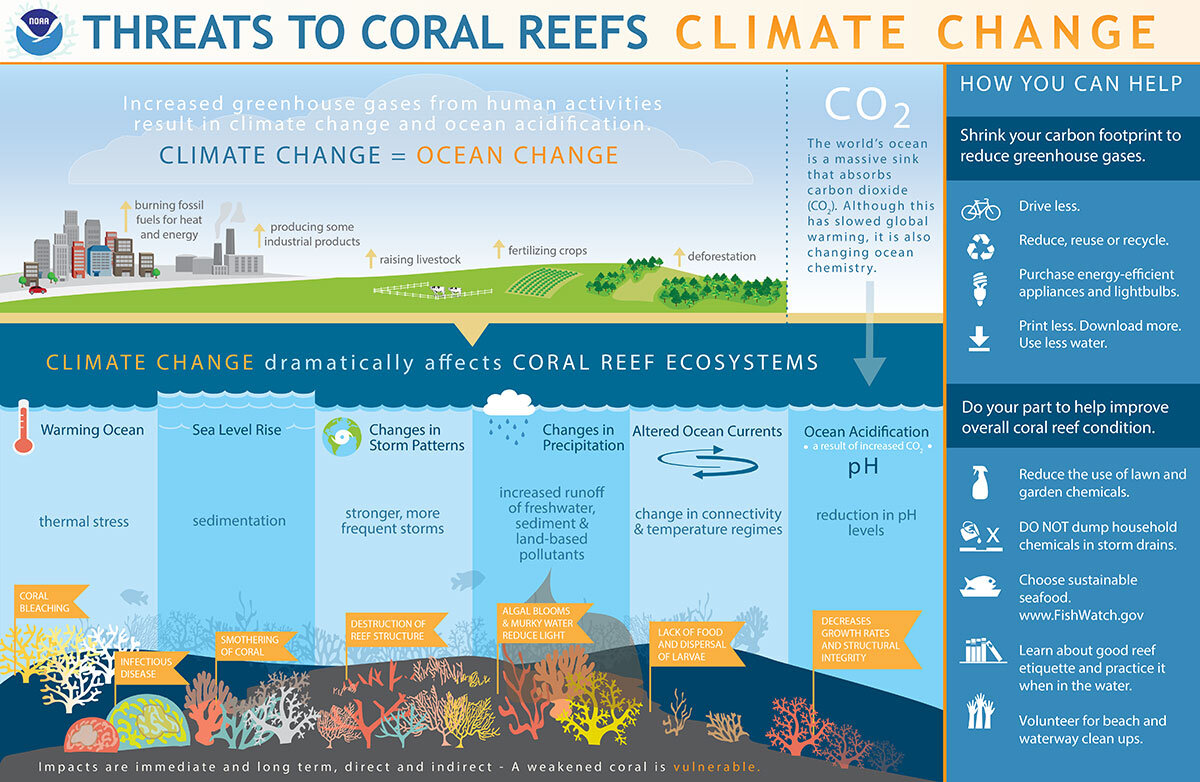Climate Change Impacts on Coral Reefs
Weather is the change in atmospheric patterns of a particular location over short periods. Climate is the change in weather patterns of a specific area over long periods. The time of climate change usually can be anywhere from hundreds to millions of years. Some examples of climate change include examining alterations in precipitation or temperature levels of a specific place over centuries or more. Furthermore, a change in the climate of Earth is considered to be climate change. The climate of our beloved planet Earth is constantly changing. Earth has been through phases where it experienced cooling in some and warming in others since its existence. The earth is currently going through a warming stage. The temperature of Earth has increased by one degree Fahrenheit within the last century. This change might appear minimal, but it can cause severe outcomes due to accumulated minimal changes. Certain changes can be observed today, including melting polar caps and the rise in ocean levels.
Coral reefs are composed of many small corals known as polyps, which are marine invertebrates. Polyps have rough exteriors that are made of calcium carbonate, and they stay in the same place. With the help of other animals with similar characteristics, corals create reefs. Coral reefs make a critical ecosystem for animals in the ocean. This ecosystem creates food and a home for different marine wildlife within its structure. Corals are scattered throughout the sea. Coral reefs are created in the tropic regions of the earth, where the ocean is warm and shallow. Coral reefs have many benefits, such as protecting coastlines from a few threats, creating jobs for certain groups of people, and more. Some businesses generate a lot of revenue on the local level by providing unique recreational activities for people exploring coral reefs. All of the coral reefs in the world were estimated to have an economic value of close to tens of billions USD annually. Figure 1 shows an image of a coral reef.
Climate change poses the most significant risk to coral reef ecosystems on a worldwide scale. The increase in the number of outcomes of infectious disease outbreaks and important bleaching occurrences for corals is due to increases in temperature levels which causes the ocean to become warmer. As sea level rise keeps on increasing because of climate change, the probability of sedimentation increase to coral reefs is likely to occur to reefs close to sediments that come from references on the land. The smothering of coral can be made possible through sedimentation runoff. Climate change modifies storm patterns. An alteration in storm patterns yields different storm intensity levels, which tend to be stronger and appear more frequently, which can cause the demolition of coral reefs. Changes in precipitation levels have been more frequent due to climate change. As patterns of rainfall change, the levels of the draining away of freshwater, sediment, and pollutants that come from the land tend to rise, which in return significantly affects algal blooms and causes the water to be dark and dirty and lowers sunlight. In addition, climate change has modified ocean circulation behaviors. The difference in ocean circulation behaviors alters the movement path of currents and the flow of temperatures throughout the ocean, which reduces the availability of food for corals and hinders coral larvae scatteration. Finally, climate change has caused an increase in carbon dioxide levels which produced ocean acidification. The chemistry of the waters in the ocean changes, and pH levels decrease, becoming more acidic. In return, this change lowers coral growth rates and the ability of corals to maintain their current forms. A summary of these climate change impacts on coral reef ecosystems appears below in Figure 2. Figure 2 also shows personal reduction of carbon footprint methods and personal methods to helping aid the current situation facing coral reefs.
Written by Abdullah Almezyad
Citations:
[1] What Is Climate Change? (2014, May 14). NASA. https://www.nasa.gov/audience/forstudents/k-4/stories/nasa-knows/what-is-climate-change-k4.html
[2] What is a coral reef? (n.d.). National History Museum. Retrieved June 9, 2021, from https://www.nhm.ac.uk/discover/quick-questions/what-is-a-coral-reef.html
[3] Coral reef ecosystems. (n.d.). NOAA. Retrieved June 9, 2021, from https://www.noaa.gov/education/resource-collections/marine-life/coral-reef-ecosystems
[4] Goinyk, V. (n.d.). Colorful Coral Reef [Photograph]. From the Grapevine. https://www.fromthegrapevine.com/nature/these-colorful-coral-reefs-shocked-scientists
[5] NOAA. (n.d.). How does climate change affect coral reefs? Retrieved June 9, 2021, from https://oceanservice.noaa.gov/facts/coralreef-climate.html#:%7E:text=Climate%20change%20 dramatically%20effects%20 coral%20reef%20ecosystems&text=Climate%20change%20leads%20to%3A,land%2Dbased%20sources%20of%20sediment




